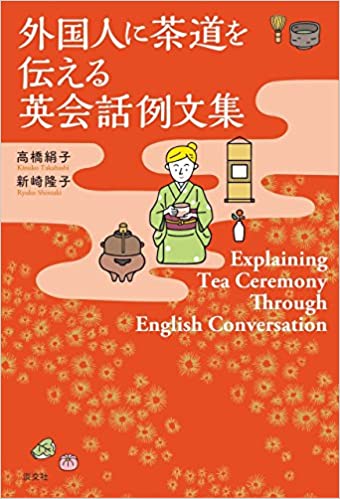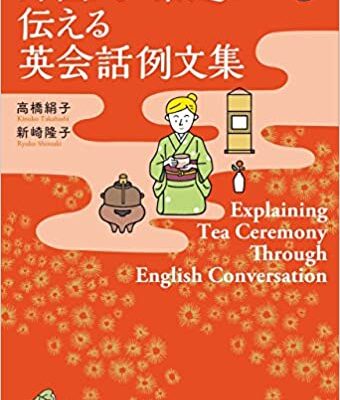高橋絹子、新崎隆子 著「外国人に茶道を伝える英会話例文集」淡交社
通訳ガイドの皆さんは、お客様を茶道体験にお連れしたりしませんか?私の仕事でも、海外からの研修生を京都や奈良でお茶体験にお連れすることが多いです。特に京都では四条通の阪急電鉄の烏丸駅と河原町駅の間にある福寿園のビルによく行きます。簡単な表現は、お店の方も英語を使われますが、込入ってくると、通訳ガイドさんの出番です。
でも、お茶の英語って知らないですよね。そんな時に、一度目を通しておくことをお勧めするのが、本書です。私も福寿園のレジで本書を見つけ、即決で購入しました。
便利な表現として、茶道でよく使う表現もまとめられていて、便利です。英訳を載せると著作権に触れると思うので、どんな日本語が載っているか少し例を書きます。
「お相伴いたします」 「お点前頂戴いたします」 「にじりでる(さがる)」
などです。茶道に詳しい方は、動作をイメージできるので、直訳をしてでも英訳できますが、とっさには、イメージできない日本語を英語には訳せないと思います。
本編の英訳には、薄茶と濃茶の量の違い、お茶菓子の種類、掛け軸の言葉、などがあります。お茶室でお茶をいただくと、お店の方が、その日の生け花や、床の間の掛け軸について説明されることがありませんか?
生け花は、花の名前を知らなくても、実物を共に見ているので、ホスト側がどういう思いでこの花を選んだのかなどの理由を説明すると、わかっていただけると思います。ただ、大変なのは掛け軸です。絵は何とかなりますが、禅語や漢文が出てくるとお手上げになります。私もお茶室に行くときは、前日に掛け軸は何が掛かっているのか確かめています。よくあるのが、「〇」を書いた円相ですね。これも意味をいろいろ調べて、自分なりに納得のいく英文を準備するようにしています。
時々、調べてもよくわからない漢文もあります。現場で、お店の人に聞くと、逆に泥沼にはまっていくことも多いので、一部でもわかっていることを、自信をもって話すようにしています。
本書は、お茶についても理解が深まるので、手元に置いておきたい一冊です。(完)

外国人に茶道を伝える英会話例文集 Explaining Tea Ceremony Through English Conversation [ 高橋絹子 ]
価格:1,650円
(2021/5/25 17:02時点)
感想(0件)
English Conversation Examples for Communicating the Tea Ceremony to Foreigners (English)
Kinuko Takahashi and Takako Shinzaki, “A Collection of English Conversation Examples for Communicating the Tea Ceremony to Foreigners,” Tankosha
Do you, as an interpreter guide, ever take your clients to experience tea ceremony? In my work, I often take trainees from overseas to Kyoto and Nara to experience tea ceremony. Especially in Kyoto, I often go to the Fukujyuen building located between Karasuma and Kawaramachi stations of Hankyu Railway on Shijo Street. The shopkeepers use English for simple expressions, but when you get into it, it’s time for an interpreter guide.
But you don’t know English for tea, do you? In such a case, I recommend that you take a look at this book. I also found this book at the checkout counter of Fukujuen and bought it immediately.
There is also a useful list of expressions that are often used in the tea ceremony. I think it would violate copyright if I posted the English translation, so I’ll give a few examples of what kind of Japanese is in the book.
“I’ll be your companion.” “I’ll be your guest.” and etc.,
If you are familiar with the tea ceremony, you can visualize the action and translate it directly into English, but if you can’t visualize it, you can’t translate it into English.
English translations of this volume include the difference in the amount of light and dark tea, types of tea cakes, and words on hanging scrolls. When you have tea in a teahouse, do you ever hear the shopkeeper explain about the flower arrangement of the day or the hanging scrolls in the alcove?
For ikebana (Japanese floral art), even if you don’t know the name of the flower, you have seen the actual flower with guests together, so if you explain the reason why the host chose the flower, I think the guests will understand. However, the hardest part is the hanging scrolls. I can handle the pictures, but when it comes to Zen words and Chinese sentences, I am at a loss. When I go to a tea room, I check the day before to see what kind of scrolls are hanging there. One of the most common is a circle with a “0” written on it. I look up the meanings of these and try to prepare English texts that make sense to the guests and me.
Sometimes, there are some Chinese words that I don’t understand even after looking them up. In the field, when I ask people in the store, I often get bogged down in the opposite direction, so I try to speak with confidence about what I know even partially.
This book is a good one to have on hand as it will give you a better understanding of tea. (End)
Exemples de conversation en anglais pour communiquer la cérémonie du thé aux étrangers (Français)
Kinuko Takahashi et Takako Shinzaki, “A Collection of English Conversation Examples for Communicating the Tea Ceremony to Foreigners”, Tankosha.
En tant que guide interprète, emmenez-vous parfois vos clients découvrir la cérémonie du thé ? Dans le cadre de mon travail, j’emmène souvent des stagiaires étrangers à Kyoto et à Nara pour découvrir la cérémonie du thé. À Kyoto en particulier, je me rends souvent dans le bâtiment Fukujyuen, situé entre les gares de Karasuma et de Kawaramachi du chemin de fer Hankyu, dans la rue Shijo. Les commerçants utilisent l’anglais pour les expressions simples, mais quand on entre dans le vif du sujet, il est temps de faire appel à un guide interprète.
Mais vous ne connaissez pas l’anglais pour le thé, n’est-ce pas ? Dans ce cas, je vous recommande de jeter un coup d’œil à ce livre. J’ai également trouvé ce livre à la caisse de Fukujuen et je l’ai acheté immédiatement.
Il y a aussi une liste utile d’expressions souvent utilisées dans la cérémonie du thé. Je pense que je violerais les droits d’auteur si je publiais la traduction anglaise, je vais donc donner quelques exemples du type de japonais que contient le livre.
“Je serai votre compagnon.” “Je serai votre invité”. Et ainsi de suite,
Si vous connaissez la cérémonie du thé, vous pouvez visualiser l’action et la traduire directement en anglais, mais si vous ne pouvez pas la visualiser, vous ne pouvez pas la traduire en anglais.
Les traductions anglaises de ce volume portent notamment sur la différence entre la quantité de thé clair et de thé foncé, les types de gâteaux au thé et les mots sur les parchemins suspendus. Lorsque vous prenez le thé dans une maison de thé, entendez-vous parfois le commerçant expliquer la composition florale du jour ou les parchemins suspendus dans l’alcôve ?
Pour l’ikebana (art floral japonais), même si vous ne connaissez pas le nom de la fleur, vous avez vu la fleur réelle avec les invités ensemble, donc si vous expliquez la raison pour laquelle l’hôte a choisi la fleur, je pense que les invités comprendront. Cependant, la partie la plus difficile est celle des parchemins à suspendre. Je peux gérer les images, mais lorsqu’il s’agit de mots zen et de phrases chinoises, je suis perdue. Lorsque je me rends dans un salon de thé, je vérifie la veille quel type de parchemins y sont accrochés. L’un des plus courants est un cercle avec un “0” écrit dessus. Je cherche leur signification et j’essaie de préparer des textes en anglais qui aient un sens pour les invités et pour moi.
Parfois, il y a des mots chinois que je ne comprends pas, même après les avoir recherchés. Sur le terrain, lorsque je demande aux gens dans le magasin, je m’embourbe souvent dans le sens inverse, alors j’essaie de parler avec assurance de ce que je connais même partiellement.
Il est bon d’avoir ce livre à portée de main car il vous permettra de mieux comprendre le thé. (Fin)
